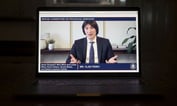It’s holiday time, and you’re likely to be celebrating with friends and family, shopping, and thinking gratefully about the year that passed and the year to come. Very nice! But it’s also time for predictions. For some reason, the changing calendar opens a channel to market observers’ mystical powers, allowing our third eyes to see the future. We make predictions, and investors listen breathlessly. Some of us wind up in the news.
But have you noticed how much financial predictions resemble horoscopes—so broad that they are almost always right, one way or another?
‘The economy will strengthen!’ or ‘Europe will rebound,’ are so vague that it’s hard to be wrong. Eventually these events will come to pass, if only for a few market sessions. And then you can say, “It’s just as [INSERT NAME HERE] predicted!”
The other interesting thing about these annual predictions: no one ever goes back to judge their success. Let’s assume that a very few predictions come to fruition; would that make investors less likely to focus on them?
Warren Buffett famously said “Forecasts may tell you a great deal about the forecaster; they tell you nothing about the future.”
Yet, predictions make for great marketing. As we all know from the findings of behavioral finance, humans love to create and extrapolate from patterns that may or may not be real. To work as marketing, predictions tend to have four qualities:
1) They have to be very big picture and use broad language that’s hard to evaluate.
2) They are not very actionable. Saying the U.S. economy will rebound—that gives me no information for investing.
3) They should include one number just specific enough to make you credible—and it should not be very different from the status quo. If, for example, you ask 20 experts to predict stock market performance, they tend to be very tightly clustered around, say, 5% to 8% growth for the S&P. What they miss is the really important stuff: the ’08s and ’09s, or the booms. This is when an accurate prediction could make you a fortune or save you from a disastrous loss—but extreme market moves rarely if ever enter the conversation.
4) The risks of being wrong outweigh the rewards of being right. This is why people make wishy-washy predictions. But there’s also a small group of ‘permabears,’ like Peter Schiff, John Mauldin, Marc Faber and many others. Every eight years or so, the market suffers a precipitous decline and they’re proven ‘right.’ They receive accolades as brilliant soothsayers of the market, despite all the years they got it all wrong.
When a client asks my opinion about a newsletter or blog that predicts something like the price of gold rocketing up to $4,000 an ounce, or a looming stock market crash, I usually respond with a favorite quote from the great investor William Bernstein: “There are two kinds of investors, be they large or small: those who don’t know where the market is headed, and those who don’t know that they don’t know. Then again, there is a third type of investor–the investment professional–who indeed knows that he or she doesn’t know, but whose livelihood depends upon appearing to know.”
Educated Guesses
Even the most expert investors rely on guesswork, to an extent. Do you want to change your weightings to large caps or small, domestic or foreign? You will make a decision that’s well supported by research and in your clients’ best interests. But at the end of the day, it’s a guess, and you’re as likely to be wrong as right. That was the ‘Aha!’ moment that pulled me away from active investing.







 November 28, 2016 at 11:22 PM
November 28, 2016 at 11:22 PM











 Copyright © 2024 ALM Global, LLC. All Rights Reserved.
Copyright © 2024 ALM Global, LLC. All Rights Reserved.